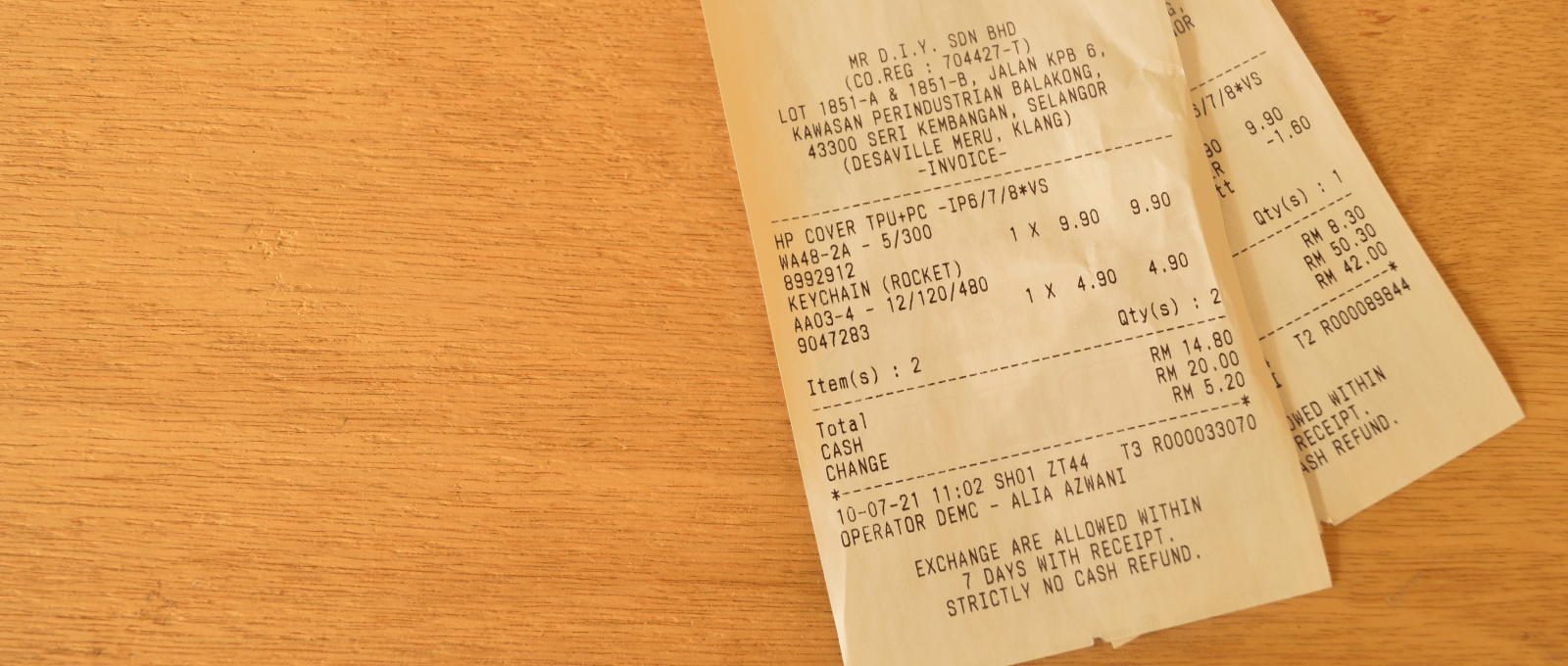In the realm of transactional documentation, paper receipts have played a significant role for decades. They have served as tangible proof of purchase and as a reference for returns, exchanges, and warranty claims. However, as technology advances, paper slips’ relevance is steadily diminishing.
In this article, we delve into the history and purpose of paper receipts, explore their environmental impact, discuss the bottlenecks they create for retail businesses, and ultimately highlight the 7 compelling reasons behind why they are losing significance.
What Is A Paper Receipt?
A paper receipt is a document given to customers by sellers or businesses after a purchase. It contains important information like the date, time, items bought, prices, payment method, and store details. These are usually printed on a small piece of paper. They serve several purposes, such as facilitating returns, helping you track your expenses, and serving as proof of your purchase.
History of Paper Receipts
Paper receipts have been an integral part of transactions since the mid-19th century. They were initially introduced to document and authenticate sales and purchases. They served as proof of purchase, allowing customers to verify their acquisition of goods or services. For retailers, receipts provided a way to track sales, monitor inventory levels, and facilitate accounting and financial reporting.
In the early days, handwritten receipts were commonly used. As commerce and trade expanded, businesses sought more efficient methods of documenting transactions. This led to the development of printed receipts using mechanical devices such as typewriters and cash registers.
Over time, printed receipts became essential to business operations, enabling retailers to maintain accurate sales records, reconcile accounts, and meet legal and regulatory requirements. They served as a means of proof for tax purposes and were crucial in resolving disputes between buyers and sellers.
How are Paper Receipts Used?
In traditional retail settings, paper receipts are generated through point-of-sale (POS) systems or cash registers. The receipt typically contains essential information such as the date, time, items purchased, prices, and store details. Customers receive a physical copy of the receipt, while businesses retain a duplicate for record-keeping purposes.
Are Paper Receipts Eco-friendly?
Despite their long-standing presence, paper receipts come with significant environmental drawbacks. Their production requires consuming valuable resources, including trees, water, and energy. Moreover, they contribute to waste accumulation, often discarded or forgotten in wallets, purses, or bins.
According to one report, the production of paper receipts in the United States alone results in the utilization of over 3 million trees, 9 billion gallons of water, and the emission of approximately 4 billion pounds of CO2 annually. These staggering figures highlight the significant environmental impact of paper receipt production and emphasize the need for more sustainable alternatives.
The sheer volume of paper slips generated globally contributes to deforestation and the depletion of natural resources. Additionally, the printing process involves chemical treatments and energy consumption, further exacerbating their environmental impact.
Many receipts are made from thermal paper, which contains a coating of chemicals, including Bisphenol A (BPA) or Bisphenol S (BPS). These chemicals have raised concerns due to their potential health risks upon exposure.
Bottlenecks of Traditional Receipts for Retail Businesses
Traditional printed receipts can create various challenges and bottlenecks for retail businesses:
- Slower Checkout Processes: Printing and distributing paper can slow checkout, resulting in longer queues and customer dissatisfaction.
- Physical Storage and Management: Retailers often face difficulty storing, organizing, and archiving receipts. This requires physical space, filing systems, and resources for retrieval when necessary.
7 Reasons Paper Receipts Are Losing Ground
Digital receipts, a growing alternative to paper receipts, are transforming transactional processes. They are electronic versions of receipts that can be delivered via email or mobile applications. Here are seven key reasons why e-receipts are gaining prominence:
1. The Rise of Digitalization
Digitalization and the widespread use of smartphones have paved the way for the adoption of paperless receipts. Customers can receive and store receipts digitally, eliminating the need for physical copies.
2. Cost Efficiency
E-receipts reduce expenses associated with printing, paper, ink, and storage. Businesses can significantly cut down on operational costs by embracing digital alternatives.
3. Data Accessibility and Security
The digitalization of receipts offers enhanced accessibility and security. They can be easily searched, retrieved, and organized digitally, eliminating the need for manual sorting and storage. Cloud-based storage ensures data security and provides a backup in case of loss or damage.
4. Consumer Preference and Convenience
Modern consumers increasingly favor convenience and streamlined experiences. Digital slips allow customers to access their transaction history, make returns or exchanges, and track purchases electronically. This eliminates the clutter and inconvenience of storing physical receipts.
5. Personalization and Marketing Opportunities
Electronic transactions provide businesses with opportunities for personalized marketing. By capturing customer information, businesses can send targeted offers, promotions, and product recommendations directly to customers’ inboxes, fostering engagement and customer loyalty.
6. Time Analytics
Unlike traditional receipts, digital sales slips enable businesses to gather valuable data on purchasing patterns, customer preferences, and spending habits. This data can be utilized to make guided decisions, optimize marketing strategies, and enhance customer experiences.
7. Streamlined Checkout Processes
Online receipts eliminate the need for printing and distributing physical copies, resulting in faster and more efficient checkout processes. This improves customer satisfaction and contributes to a more seamless retail experience.
Paper Receipts in Non-Retail Environments
While printed receipts are commonly associated with retail transactions, their usage extends far beyond traditional retail settings. They are prominent in non-retail environments, including service industries, healthcare, hospitality, and government-related transactions. Recognizing the prevalence of conventional receipts in these contexts and their challenges can provide valuable insights into exploring alternative solutions and advancements.
Following are the industries where paper receipts are fundamental to daily business.
- Transportation: In the transportation industry, including airlines, railways, and taxi services, printed receipts are often issued as proof of ticket purchase or service payment. These receipts help passengers track travel expenses and are required for reimbursement or expense reporting purposes.
- Automotive Services: Automotive repair shops, car rental companies, and gas stations commonly provide written receipts to customers. These receipts are proof of payment for services rendered, maintenance work, fuel purchases, or vehicle rentals.
- Education and Training: Educational institutions, training centers, and workshops often issue receipts for tuition fees, course registrations, or educational materials.
- Event Management: Event organizers, concert venues, and conference centers frequently use receipts for ticket sales, admission fees, or merchandise purchases.
- Wholesale and Distribution: Wholesalers, distributors, and suppliers often provide paper receipts to their customers for large-scale purchases or bulk orders.
- Banking and Financial Services: Banks, credit unions, and financial institutions issue paper slips for various transactions, such as deposits, withdrawals, or currency exchanges.
- Non-profit Organizations: Non-profit organizations often issue slips to donors to acknowledge their charitable contributions.
- Utilities and Services: Utility companies, such as electricity, water, or telecommunications providers, typically issue paper receipts for bill payments.
- Construction and Contracting: Construction companies, contractors, and subcontractors often provide traditional receipts for construction materials, equipment rentals, or project expenses. These receipts help in invoicing.
Why Do Paper Receipts Still Exist?
In an era of widespread digitalization, it raises the question: Why do traditional receipts continue to exist? Despite technological advancements, the persistence of paper receipts in our daily lives is noticeable. Some of the reasons are:
- Tangible Proof of Transaction: Printed receipts are physical evidence of a completed transaction, providing customers with a tangible record of their purchase and a sense of security.
- Familiarity and Comfort: Some customers prefer to receive physical receipts. This may be because they are more familiar with those receipts or believe they are more secure. Also, these conventional receipts have been used for decades, making them a familiar and comfortable part of the shopping experience for many customers.
- Accessibility: Paper receipts do not require special technology or devices to access or store, making them universally accessible to all customers. These can be easily accessed and referenced without internet connectivity, ensuring reliability when a physical receipt is required immediately.
- Personal Record-Keeping: Some customers manually organize and track their expenses, which they find more effective and reliable than digital methods.
- Technological Limitations: Some businesses may still rely on outdated or legacy systems not equipped to handle e-receipts, making traditional receipts the only viable option.
Are Paper Receipts Required Legally?
The legal requirements for providing paper receipts vary by jurisdiction and industry.
Here are some common scenarios where physical receipts may be mandated by law:
- Consumer Protection Laws: Many countries have consumer protection laws that require businesses to provide customers with paper receipts for their purchases. These laws aim to ensure transparency, accountability, and the ability to exercise consumer rights, such as returns, exchanges, or warranty claims.
- Cash Transactions: In some jurisdictions, cash transactions above a certain threshold must be accompanied by a paper receipt. This requirement aims to prevent tax evasion and promote transparency in cash-based transactions.
- Expense Reimbursement: Some organizations, particularly business and government sectors, require physical receipts for expense reimbursement. These receipts serve as proof of expenditure and help verify the legitimacy of claims.
- Tax Compliance: Tax regulations often require businesses to issue physical receipts for their record-keeping obligations. These receipts are evidence of transactions and are used for tax reporting and audits. They help businesses accurately report their sales and expenses, and customers can use them for personal tax purposes.
Challenges of Adopting Digital Receipts
Adopting paperless receipts has become compelling as businesses navigate the digital landscape. However, this transition comes with its own set of challenges. Businesses face hurdles from technological integration to customer acceptance in fully embracing digital receipts.
Some of the key reasons include the following:
1. Technological Infrastructure
One of the primary challenges lies in establishing the necessary technological infrastructure to support digital slips. Retailers must upgrade their point-of-sale (POS) systems or invest in new digital receipt platforms. This involves hardware, software, and network upgrades, which can be costly and time-consuming.
2. Resistance to Change and Employee Training
Adopting paperless receipts requires a cultural shift within the organization. Employees must be trained to use digital receipt platforms and guide customers through the transition. Resistance to change may arise from employees who are accustomed to paper-based systems.
3. Customer Support and Assistance
The introduction of online receipts may necessitate additional customer support channels. Some customers may need assistance accessing, retrieving, or understanding digital slips. Investing in training programs for staff members to handle customer inquiries and troubleshooting can be a barrier.
Receipt Management Solution From VisionX
At VisionX, we take pride in being a leading provider of OCR services. Our innovative technology offers retailers and businesses a seamless solution to streamline their receipt management processes. Our advanced receipt OCR service enables efficient and accurate data extraction from paper receipts, eliminating the need for manual data entry. Automating this labor-intensive task empowers businesses to enhance productivity, reduce errors, and gain valuable insights from their receipt data. Our receipt management software allows you to optimize your operations, focus on core activities, and enjoy the benefits of streamlined receipt processing.
Conclusion:
The digital revolution has brought significant changes in transactional processes, leading to the gradual decline of traditional receipts. The convenience, personalization, real-time analytics, and streamlined checkout processes associated with digital alternatives are reshaping how transactions are conducted. Forward-thinking retailers are already at the forefront, diligently exploring paperless options that align with sustainability objectives and enhance customer satisfaction through a modern and hassle-free receipt experience.


